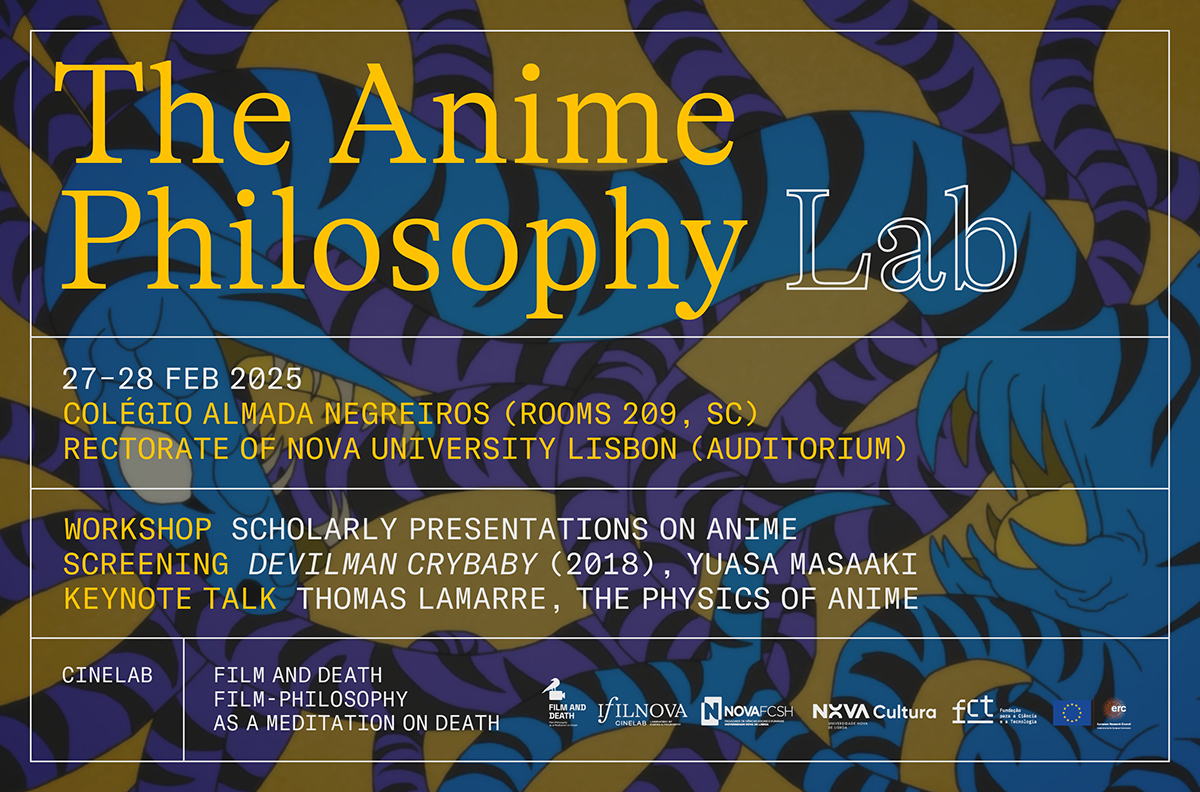The Anime Philosophy Lab

NOVA FCSH
27–28 February 2025
In recent decades, Japanese television animation, or Anime, a highly conceptualized, popular, and thought-provoking style of moving images, has received more attention in Western academic debate. Yet, in what ways could Anime contribute to the advancement of film philosophy as such? Anime raises broad and highly pertinent questions related to identity, trauma, post-war Japan, pop culture, media infrastructure, technological transformation of culture and landscape, and to human/nature relationship, emerging also as an opportunity to think about the connections, the intersections, between Western and non-Western thought.
Following the success of the workshop with Thomas Lamarre in March 2024, and given the great number and quality of the abstracts submitted to Cinema: Journal of Philosophy and the Moving Image’s call on The Anime Philosophy, the CineLab and the ERC Project FILM AND DEATH at IFILNOVA are organizing a two-day meeting for us to elaborate as a group on the Anime Philosophy. We want to assemble a collective thought production machine to bring us together, promoting discussions on our investigations of (and with) Japanese television animation.
The event is open and free of charge. Interested audiences are welcome to attend and participate in the discussions happening at Colégio Almada Negreiros and Rectorate (Campus Campolide), NOVA University Lisbon.
FULL PROGRAMME
Presentations have been organized in groups, which you can find in the programme here.
SCREENING + KEYNOTE TALK
On the first day of the workshop, a selection of episodes from Yuasa Masaaki’s Devilman Crybaby (2018) will be screened at 4:30 PM at the Rectorate of NOVA University Lisbon, followed by a keynote talk given by Thomas Lamarre (University of Chicago) on “The Physics of Anime”, at 7:00 PM.
KEYNOTE SPEAKER
Thomas Lamarre, University of Chicago
What does it mean to say that anime thinks, or that anime does philosophy? Here, instead of assuming that philosophy knows what thought is and provides the model for thinking, I propose to delve into physics, to explore the systematicity underlying the generation of concepts. It is in this way that I begin to explore the emergence of thinking in anime, via “physicity” or the articulation of systematic physical patterns. Anime thus poses some challenges, both to physics and to philosophy, for it renews perennial questions about the “laws” of physics and the ecological or (non)localizable nature of thought. Approaching anime in terms of physicity also troubles the tendency to posit a divide between unity (anime or animation in general) and variety (this or that anime). Such an approach comes with consequences, which I propose to consider through the animations of Yuasa Masaaki, especially Devilman Crybaby and Ping Pong. The use of a physics of dimensional warping in these animations takes on ethical weight as it forces a reconfiguration of the temporality of human interactions. The physicity of Yuasa’s animations thus shock us into a rethinking of the when and where of ethical action.
BIO
Thomas Lamarre teaches in the Departments of Cinema and Media Studies and East Asian Languages and Civilizations, and the Committee on Environment, Geography and Urbanization at the University of Chicago. Publications on media, thought, and material history include work on communication networks in 9th century Japan (“Uncovering Heian Japan”, 2000); silent cinema and the global imaginary (“Shadows on the Screen”, 2005); animation technologies (“The Anime Machine”, 2009) and infrastructure ecologies (“The Anime Ecology”, 2018). Major translations include Kawamata Chiaki’s “Death Sentences” (2012), Muriel Combes’s “Gilbert Simondon and the Philosophy of the Transindividual” (2012), David Lapoujade’s “William James, Empiricism, and Pragmatism” (2019), and Isabelle Stengers’s “Making Sense in Common” (2023).
Organisers: Susana Viegas, Lucas Ferraço Nassif, Patrícia Castello Branco, and Vasco Baptista Marques.

